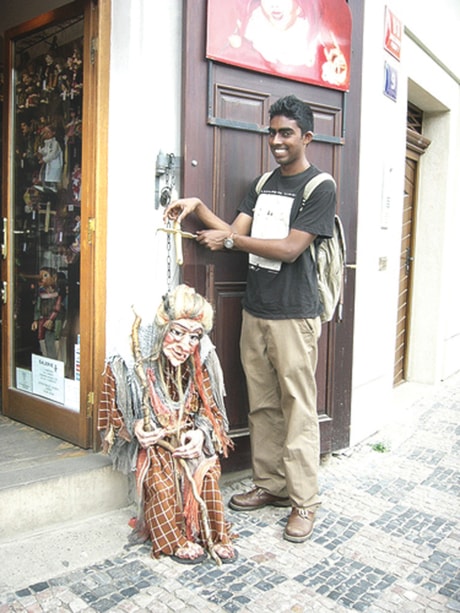PRAGUE, Czech Republic — The curtain rises in a quaint theatre in Prague’s tourist hub to reveal a sly libertine nobleman, Don Giovanni, trying to carry off Donna Anna, the Commandant’s daughter.
Anna resists and Giovanni escapes from the Commandant’s palace, pursued by Anna, who wants him punished. Her father rushes to help and is killed by Giovanni.
This is the first of many dramatic and comical scenes in Mozart’s opera Don Giovanni, composed as a gift to Prague. When Mozart wrote the tale of the incorrigible lothario, chances are he envisioned a grandiose production filled with dramatic effects, impassioned scenes and larger-than-life characters.
He probably did not expect those larger-than-life characters to be a mere two-feet tall and carved from wood — marionettes, to be exact.
I caught this absurdist and amusing production of Don Giovanni at the National Marionette Theater in Prague, which staged the city’s first marionette version of the Mozart opera in 1991 and has since performed it 3,000 times.
Marionette operas and theatre are a prominent part of Prague’s contemporary arts and culture scene, but they are also rooted in a long tradition going back to the 12th century, when marionettes were used in religious ceremonies and folk customs.
Today, they’re part of the city’s tourist industry too.
You can barely wander down a street without encountering wooden stringed puppets beckoning you to watch them dance or take them home as a pricey souvenir. These marionettes, waiting to be brought to life at nearly every corner, also add to the visitor’s sense that Prague is a fairy tale come to life, with its castles, romantic bridges, cobblestoned streets and the sounds of Vivaldi ringing out from church courtyards.
“Puppets are to Prague what pizza is to Rome,” says puppeteer Vlad Brodsky.
Families began learning the craft from puppeteers who wandered the Czech countryside. Theatre scripts and puppets were passed down through generations, and the art form became a source of national pride.
The family tradition of puppetry declined in the 19th century, but then went through a revival 100 years later, when puppet theatres began sprouting up everywhere.
Puppetry associations began forming in the early 20th century, such as The Czech Union of Friends of the Puppet Theatre in 1911. Its most active member, Jindrich Vesely, promoted puppetry across the country by publishing the magazines Czech Puppeteer and Puppeteer.
The puppetry movement intensified after the First World War when the Czechoslovak Republic was established. Over 2,000 puppet ensembles developed. Some regularly performed for children; others, like puppeteer Josef Skupa, created shows for adults. Skupa founded the Plzen Theater, created the Spejbl and Hurvinek puppets, and in 1930, launched a professional touring company.
After the Nazis invaded, the art form went underground. Puppetry began being used for political dissent; some puppeteers were considered national heroes or revolutionaries. Skupa was renowned for performing libertarian shows that called for a renewed independence. The Gestapo arrested him in 1944 and disbanded his company.
After the war, puppetry began to flourish again. Performances in Prague’s Rise Loutek Theater, founded in 1920, grew in popularity. Today the amphitheatre-shaped, art-nouveau theatre is home to the National Marionette Theater.
The production I saw at the National of “Don Giovanni,” accompanied by what sometimes sounds like an old phonograph, is amusing, though at times, silly and repetitive as the puppets are limited in what they can execute. But the story is successfully portrayed, and the production definitely makes you chuckle.
Watching this fine example of the Czech tradition of puppetry may inspire you to ponder how the art form reflects on the country’s rich and cultured history.
If you go
GETTING THERE: Direct flights to Prague can be pricey. It may be cheaper to fly to a hub like London or Amsterdam, then catch a flight on Eurostar or some other domestic airline to Prague.
NATIONAL MARIONETTE THEATER: Atecka 1, Prague, Praha 1; http://www.mozart.cz or 011-420-224-819-322. Opera tickets are US$26, available 30 minutes before a show starts. Two performances a day (in the afternoon and evening).
MARIONETTE MUSEUM: U Karlova 12, Old Town; http://www.puppetart.com or 011-420-222-220-928.
WORLD FESTIVAL OF PUPPET ART: May 17 to 31, 2009, http://www.puppetart.com/festival.htm
FOR SERIOUS WOULD-BE PUPPETEERS: Prague’s Academy of Arts (DAMU) offers degrees in “alternative and puppet theatre direction.”
TRANSIT TIP: Be sure to buy correctly zoned transit tickets if you ride the city’s public transit system, which is quite efficient. I didn’t read the ticket dispensing machine correctly, bought the wrong ticket and was confronted by transit police officers who gave me the option of 48 hours in jail or a US$38 fine.
